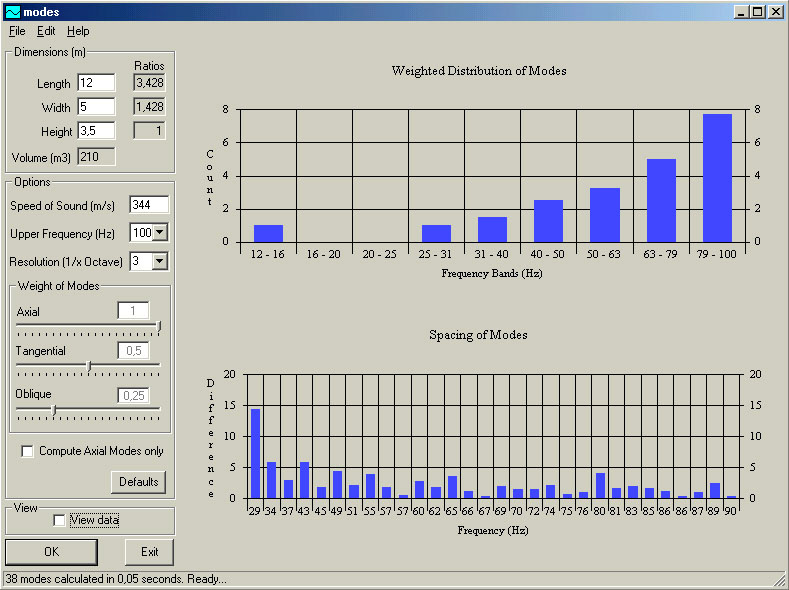My hi-fi system
I am interested in hi-fi since 1983. It all started when my brother and I tried to choose a hi-fi system to buy. Since then, I read a lot about physics, electronics, acoustics, and psychology. Evaluating sound quality is mostly related to psychology and it helps to improve one’s self-understanding. Today I am interested in psychoacoustics more than in hi-fi systems.
In 1999, I wrote an article relating to the assessment of hi-fi systems, “Bir hi-fi sistem seçiminde nelere dikkat edilmelidir?” (In Turkish). It is “published” on several websites and I receive very favourable comments about it. I also wrote a utility software to calculate resonant modes of rectangular rooms. Below is a screenshot of this software.

Image 1: Modes

Photo 1: My hi-fi system
CD Player: Sony XA7ES
Amplifier: Mark Levinson No:331
Speakers: Klipsch LaScala (vintage 1978, but in almost excellent condition)
My comments about this system:
It may seem strange to use a very powerful amplifier like No:331 with high sensitivity speakers. Most high-powered amplifiers’ transfer functions are indeed not very linear at milliwatt levels. But this is not the case with No:331. I tried many tubed (unfortunately, none SET) and solid-state gear but I found No:331 to be one of the best matches for the LaScala’s at its price level. On the minus side however, the signal-to-noise ratio of No:331 is not very high, and the frequency response irregularity of my speakers further aggravates the situation. Current LaScala’s are better in this respect.
Klipsch Heritage line loudspeakers are exemplary in that they are basically unchanged for a very long time (for Klipschorn more than 50 years). This is IMHO, due to the achievement of Paul Klipsch in finding the best compromises between parameters such as sound quality, parts selection, ease of manufacture, etc. These speakers can be improved in many ways, but they can hardly be beaten in terms of price/performance ratio. To my knowledge, LaScala is the cheapest commercially available fully horn-loaded speaker. The most important weakness of these speakers is that they are too accurate for domestic usage in terms of dynamic range. While direct radiator loudspeakers rely on distortions to imitate high sound pressure levels, horn-loaded ones actually provide them.
I had the opportunity to listen to every CD player from the Sony Esprit line as well as many others. Esprit line CD players share the same D/A converters, but support electronics, mechanics and build quality is different. Sound quality is proportional to the price. It is interesting to note that there is a striking difference in sound quality between seemingly very similar models such as XA5ES (or XA50ES) and XA7ES. The cheapest models distort unpredictably and as a consequence different instruments are not treated equally in terms of subjective amplitude, dynamics, and dimension. XA5ES is considerably better in this respect but falls short of the liquidity, beauty, and coherence of XA7ES.
My room is basically L-shaped, but the wall making the L is not parallel with any other, making an angle of about 70 degrees rather than 90 with the neighbouring walls. The room is not big enough for a smooth frequency response below 60 Hz or so. There is no acoustical treatment for early reflections. I found that this is not necessary, probably because of the narrow polar response of LaScala’s.
Describing the sound of a hi-fi system is very difficult, if not impossible. The most important characteristics of my system can be summarized as follows: It does not disturb the listener even played very loud. I can fall asleep while listening at average levels of over 90 dB SPL. So, It is not particularly involving or musical. With my old Thorens TD 166 turntable, the music was much more involving although the sound was worst in almost every conceivable area.
By the way, I listen mostly to Jazz. My favorite albums include “Köln Concert, Keith Jarret” and “Kind of Blue, Miles Davis” among many others.